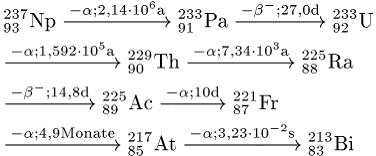Neptunium

Petra Nordinghaus-Martin
Chemie, Physikalische Chemie,
Np, Element der Gruppe der Actinoide des Periodensystems, ein Transuran-Element
(benannt nach dem Planeten Neptun, der auf Uranus folgt). In der Natur kommt es
in geringen Mengen als Begleiter in der Pechblende vor. Neptunium besitzt die
Elektronenkonfiguration [Rn]5f46d17s2 und ist radioaktiv. Bis
jetzt sind 15 Isotope mit den Massenzahlen 228-242 bekannt. Neptunium wird
durch künstliche Elementumwandlung aus Uran hergestellt. Durch Beschuss von ![]() mit langsamen Neutronen entsteht
mit langsamen Neutronen entsteht ![]() , das in
, das in ![]() zerfällt:
zerfällt:
![]()
Wird ![]() dagegen mit schnellen Neutronen beschossen, so
bildet sich
dagegen mit schnellen Neutronen beschossen, so
bildet sich ![]() , aus dem
, aus dem ![]() entsteht:
entsteht:
![]()
Da im Uran-Reaktor auch die Uran-Isotope 237 und 239 gebildet
werden, treten hier auf Grund der oben genannten Kernreaktionen die
entsprechenden Neptuniumisotope auf. Das kurzlebige Isotop ![]() wandelt sich rasch in das langlebige
Plutonium-Isotop
wandelt sich rasch in das langlebige
Plutonium-Isotop ![]() um. Dagegen reichert sich das Isotop
um. Dagegen reichert sich das Isotop ![]() im Reaktor an (0,1 % der
im Reaktor an (0,1 % der ![]() -Produktion).
Es wird technisch dazu verwendet, das Plutonium-Isotop
-Produktion).
Es wird technisch dazu verwendet, das Plutonium-Isotop ![]() herzustellen. Vom Neptunium-Isotop
herzustellen. Vom Neptunium-Isotop ![]() leitet sich die künstliche (4n +
1)-Neptunium-Zerfallsreihe ab:
leitet sich die künstliche (4n +
1)-Neptunium-Zerfallsreihe ab:


![]() .
.
Neptunium 1: Wichtiges Isotop.
| bottom-alt:solid black .6pt;padding:0cm 3.55pt 0cm 3.55pt\'>
Isotop |
bottom:solid black 1.0pt;border-right:none;
mso-border-top-alt:solid black .6pt;mso-border-bottom-alt:solid black .6pt;
padding:0cm 3.55pt 0cm 3.55pt\'>
Natürliche Häufigkeit [%] |
bottom:solid black 1.0pt;border-right:none;
mso-border-top-alt:solid black .6pt;mso-border-bottom-alt:solid black .6pt;
padding:0cm 3.55pt 0cm 3.55pt\'>
Atommasse |
bottom-alt:
solid black .6pt;mso-border-right-alt:solid black .75pt;padding:0cm 3.55pt 0cm 3.55pt\'>
Halbwertszeit T1 / 2 |
| bottom:solid black 1.0pt;border-right:none;mso-border-top-alt:solid black .6pt;
mso-border-top-alt:solid black .6pt;mso-border-left-alt:solid black .75pt;
mso-border-bottom-alt:solid black .6pt;padding:0cm 3.55pt 0cm 3.55pt\'>
237Np |
bottom:solid black 1.0pt;
mso-border-top-alt:solid black .6pt;mso-border-top-alt:solid black .6pt;
mso-border-bottom-alt:solid black .6pt;padding:0cm 3.55pt 0cm 3.55pt\'>
0 |
bottom:solid black 1.0pt;
mso-border-top-alt:solid black .6pt;mso-border-top-alt:solid black .6pt;
mso-border-bottom-alt:solid black .6pt;padding:0cm 3.55pt 0cm 3.55pt\'>
237,048 167 |
bottom:solid black 1.0pt;border-right:solid black 1.0pt;mso-border-top-alt:
solid black .6pt;mso-border-top-alt:solid black .6pt;mso-border-bottom-alt:
solid black .6pt;mso-border-right-alt:solid black .75pt;padding:0cm 3.55pt 0cm 3.55pt\'>
2,14 × 106 a |
Neptunium 2: Allgemeine, chemische und festkörperphysikalische Eigenschaften.
| bottom:none;border-right:none;
mso-border-top-alt:solid black .75pt;mso-border-left-alt:solid black .75pt;
padding:0cm 3.55pt 0cm 3.55pt\'>
Ordnungszahl |
bottom:none;border-right:solid black 1.0pt;
mso-border-top-alt:solid black .75pt;mso-border-right-alt:solid black .75pt;
padding:0cm 3.55pt 0cm 3.55pt\'>
93 |
|
relative Atommasse (12C = 12,000 0) |
237,048 2 |
|
Dichte [g cm-3] |
20,45 |
|
Molvolumen [cm3] |
11,71 |
| bottom:solid black 1.0pt;border-right:none;
mso-border-left-alt:solid black .75pt;mso-border-bottom-alt:solid black .75pt;
padding:0cm 3.55pt 0cm 3.55pt\'>
Oxidationszahlen |
bottom:solid black 1.0pt;border-right:solid black 1.0pt;
mso-border-bottom-alt:solid black .75pt;mso-border-right-alt:solid black .75pt;
padding:0cm 3.55pt 0cm 3.55pt\'>
II-VII |
Neptunium 3: Thermische und elektromagnetische Eigenschaften.
| bottom:none;border-right:none;
mso-border-top-alt:solid black .75pt;mso-border-left-alt:solid black .75pt;
padding:0cm 3.55pt 0cm 3.55pt\'>
Siedetemperatur [K] |
bottom:none;border-right:solid black 1.0pt;
mso-border-top-alt:solid black .75pt;mso-border-right-alt:solid black .75pt;
padding:0cm 3.55pt 0cm 3.55pt\'>
4 175 |
|
Schmelztemperatur [K] |
913 |
|
Siedeenthalpie [kJ mol-1] |
336,6 |
|
Schmelzenthalpie [kJ mol-1] |
9,46 |
|
Wärmeleitfähigkeit (300 K) [W m-1K-1] |
6,3 |
|
thermischer Längenausdehungskoeffizient [10-6 K-1] |
27,5 |
| bottom:solid black 1.0pt;border-right:none;
mso-border-left-alt:solid black .75pt;mso-border-bottom-alt:solid black .75pt;
padding:0cm 3.55pt 0cm 3.55pt\'>
spezifischer Widerstand [10-8 Wm] |
bottom:solid black 1.0pt;border-right:solid black 1.0pt;mso-border-bottom-alt:
solid black .75pt;mso-border-right-alt:solid black .75pt;padding:0cm 3.55pt 0cm 3.55pt\'>
122 |
Neptunium 4: Atom- und kernphysikalische Eigenschaften.
| bottom:none;border-right:none;
mso-border-top-alt:solid black .75pt;mso-border-left-alt:solid black .75pt;
padding:0cm 3.55pt 0cm 3.55pt\'>
Termsymbol |
bottom:none;border-right:solid black 1.0pt;
mso-border-top-alt:solid black .75pt;mso-border-right-alt:solid black .75pt;
padding:0cm 3.55pt 0cm 3.55pt\'>
5I4, 6L11 / 2 |
|
1. Ionisierungsenergie [eV] |
6,27 |
|
Elektronegativität (Pauling) |
1,36 |
|
effektive Kernladung (Slater) |
1,80 |
|
Ionenradius (Np7+) [nm] |
0,071 |
|
Atomradius [nm] |
0,131 |
|
Kernspin (237Np) |
5/2 |
|
magnetisches Moment (237Np) [mK] |
3,14 |
| bottom:solid black 1.0pt;border-right:none;
mso-border-left-alt:solid black .75pt;mso-border-bottom-alt:solid black .6pt;
padding:0cm 3.55pt 0cm 3.55pt\'>
Einfangquerschnitt für thermische Neutronen (237Np) [barn] |
bottom:solid black 1.0pt;border-right:solid black 1.0pt;mso-border-bottom-alt:
solid black .6pt;mso-border-right-alt:solid black .75pt;padding:0cm 3.55pt 0cm 3.55pt\'>
180 |
Techniklexikon.net
Das freie Technik-Lexikon. Fundierte Informationen zu allen Fachgebieten der Ingenieurwissenschaften, für Wissenschaftler, Studenten, Praktiker & alle Interessierten. Professionell dargeboten und kostenlos zugängig.
Techniklexikon
Modernes Studium der Physik sollte allen zugängig gemacht werden.